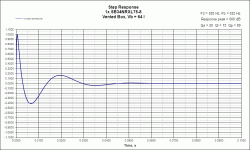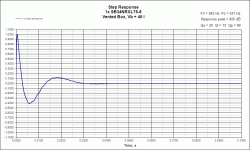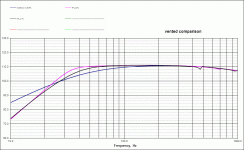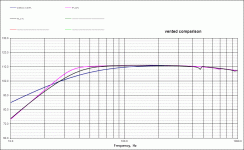It just my perception the low Q sealed box is lower distortion.
Actually, ported boxes are usually lower distortion because they provide better damping at resonance.
I think it's wrong to generalise that ported or sealed is best. As planet10 has hinted, it's more than just the box that makes the speaker. You have to think as a system.
my comment is that any sensible sized closed box bass speaker does not produce adequate bass for most audio signal listening.comments about closed speakers being the only really accurate in the bass response
The box becomes enormous and even then the loading rolls off some of the wanted bass signal.
All these closed box bass speaker require some EQ.
Sorry to be blunt, but the premise of this thread is rather silly. Unless you have designed your own properly optimized bass-reflex system, you may not have any idea what it can sound like. Most commercial examples are indeed a cheap way to force deeper bass out of a tiny woofer. As I have said previously, it doesn't have to be that way.
Francis,
Beat me to the point. The only way to make a call is to build the same speaker in both properly designed sealed and ported. Even that will be a bit difficult as to make all things equal, the outside of the box has to be the same. Then you get into finding a driver that is well suited for both sealed and ported. Most are not, as each prefers different Q. I have done sop several times, most recently with the Dayton RS 150 and 170's. Years ago with Great Americian 8" poly wonders.
More issues? If you are crossing over to a sub, you may be well above where there is any difference. Most 6.5 inch md-bass can do an honest 50Hz ported, about 60 sealed. If you cross over at 80, you will not hear a difference that I can find.
Still, I have built a lot of speakers, and I prefer low Q sealed boxes. For sure, easier for a first timer to build successfully as less test equipment is needed. (Simulations lie). I prefer rear ports, but that means pulling the speaker out from the wall/absorbers. Not good for image/soundstage. My current listening is with all low Q subs, two pair of sealed mains, two pair ported and one pair IB. Room to room, it depends. I would like to work with IB some more.
Beat me to the point. The only way to make a call is to build the same speaker in both properly designed sealed and ported. Even that will be a bit difficult as to make all things equal, the outside of the box has to be the same. Then you get into finding a driver that is well suited for both sealed and ported. Most are not, as each prefers different Q. I have done sop several times, most recently with the Dayton RS 150 and 170's. Years ago with Great Americian 8" poly wonders.
More issues? If you are crossing over to a sub, you may be well above where there is any difference. Most 6.5 inch md-bass can do an honest 50Hz ported, about 60 sealed. If you cross over at 80, you will not hear a difference that I can find.
Still, I have built a lot of speakers, and I prefer low Q sealed boxes. For sure, easier for a first timer to build successfully as less test equipment is needed. (Simulations lie). I prefer rear ports, but that means pulling the speaker out from the wall/absorbers. Not good for image/soundstage. My current listening is with all low Q subs, two pair of sealed mains, two pair ported and one pair IB. Room to room, it depends. I would like to work with IB some more.
You have speakers optimized for BR and speakers optimized for sealed, not both. Using one speakers for both alignments begins that slippery slide ....


Using one speakers for both alignments begins that slippery slide ....
quite many woofers for subs are designed to go exstremely low in vented
and those especially appear to me like they would work optimal in closed box
but cannot claim I have tried it
You have speakers optimized for BR and speakers optimized for sealed, not both. Using one speakers for both alignments begins that slippery slide ....

Nope, drivers with a Qts of around .37 actually work great in both alignments.
Nope, drivers with a Qts of around .37 actually work great in both alignments.
ahh ... yes, but you also want low Fs for a good closed box allignment
in closed you will not get low bass without low Fs
that said, it's actually quite funny to see a 24" woofer with low Fs roll off at 50hz because of its equally very low Qts
but I'm sure it will take some serious beating 😀
No.
The alignment depends on the ratio of Vbox and Vas of the driver applied as a factor to Qts..
Qbox (alignment) is not related to Fs.
The alignment depends on the ratio of Vbox and Vas of the driver applied as a factor to Qts..
Qbox (alignment) is not related to Fs.
I have noticed we are now in 'lounge area' 😀
did I say Qbox allignment
well, evenso, you still want low Fs woofer for closed box allignment 😉
you need a woofer with low Fs to get low bass in closed box
Qbox (alignment) is not related to Fs.
did I say Qbox allignment

well, evenso, you still want low Fs woofer for closed box allignment 😉
you need a woofer with low Fs to get low bass in closed box
Alignment is the way the speaker adopts a high pass filter type response and thus creates a "shape" of roll off.
That is directly related to Qbox.
eg Butterworth alignment equates to Qbox = 1/sqrt(2).
Stating "alignment" implies Q.
That is directly related to Qbox.
eg Butterworth alignment equates to Qbox = 1/sqrt(2).
Stating "alignment" implies Q.
Actually, ported boxes are usually lower distortion because they provide better damping at resonance.
I think it's wrong to generalise that ported or sealed is best. As planet10 has hinted, it's more than just the box that makes the speaker. You have to think as a system.
I agree with the second comment completely. That is why I am studying amplifier design. It is changing my speaker design ideas.
I disagree with the first. We actually (or should) use sealed boxes above their resonance so that is a bit misleading. Too much of a generalization but F3 will be about Fs with a maximally flat .7 system Q. For a typical 7 inch mid-bass in a QB3, F3 may be a full 20 Hz lower.
The OP's question was which do we prefer. I prefer low Q (.6 to .5) sealed if all things being equal, which they are not. They sound cleaner to me. Maybe it is because I am forced to cross them over to a sub while they are still working in a very linear excursion range where if ported, one is tempted to get them to do more than they should.
Low Qts (below.35, preferable in the .20's) for BR , Qts above .4, best for sealed cabinet. Low FS for sure regardless of alignment.
Advertised QTS is always higher than measured , i usually like to break the suspension in by running a continuous sinewave overnight before running measurements ...
Advertised QTS is always higher than measured , i usually like to break the suspension in by running a continuous sinewave overnight before running measurements ...
I'm curious about thoughts on differences between vented tuning. It seems that the usual complaint about vented is related to the more sluggish transisent response...
Attached are graphs of an SB accoustics SB34NRXL75-8 driver simulated in two different vented boxes.
1st 64L with 32Hz tuning (which is pretty much what unibox recommended as "standard design" and the second is a 45L box with 31Hz tuning.
Taking the ripple due to port resonance (in the 45L box) out of the equation, do you think that the differences presented in the attached step responses would be enough to make someone prefer the smaller enclosure over the larger one, ie subjectively feel that the smaller had tighter bass? The third pic shows the difference in the rolloff between the two options.
edit: added sealed to the comparison graph. 64L Q 0.5
Tony.
Attached are graphs of an SB accoustics SB34NRXL75-8 driver simulated in two different vented boxes.
1st 64L with 32Hz tuning (which is pretty much what unibox recommended as "standard design" and the second is a 45L box with 31Hz tuning.
Taking the ripple due to port resonance (in the 45L box) out of the equation, do you think that the differences presented in the attached step responses would be enough to make someone prefer the smaller enclosure over the larger one, ie subjectively feel that the smaller had tighter bass? The third pic shows the difference in the rolloff between the two options.
edit: added sealed to the comparison graph. 64L Q 0.5
Tony.
Attachments
Last edited:
Fs is a different parameter.and your personal experience is that Fs does not matter
It has little to do with alignment.
It has to do with how far, or how little, the bass frequency response extends.
The "shape" of the response depends on the alignment.
Choose your driver.
Model it's performance.
Decide if that model's predictions meet your requirements.
If not, select another driver and repeat.
edit: added sealed to the comparison graph. 64L Q 0.5
Tony.
really nice looking closed box alignment 🙂
yeah, I know the SB 12" got that nice low Fs, and combined with the right medio Qts, and bingo ... 😛
Attachments
- Status
- Not open for further replies.
- Home
- Member Areas
- The Lounge
- Do you prefer the bass from closed or vented speakers ?



